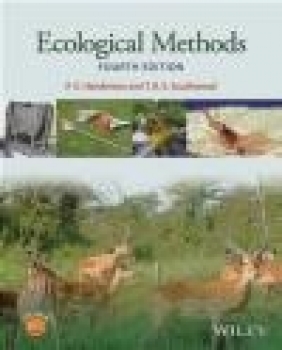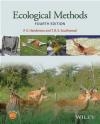Ecological Methods
T. R. E. Southwood, Peter Henderson
Ecological Methods
T. R. E. Southwood, Peter Henderson
- Wydawnictwo: John Wiley
- Rok wydania: 2016
- ISBN: 9781118895283
- Ilość stron: 656
- Oprawa: Miękka
Niedostępna
Opis: Ecological Methods - T. R. E. Southwood, Peter Henderson
4th edition of this classic Ecology text * Computational methods have largely been replaced by descriptions of the available software * Includes procedure information for R software and other freely available software systems * Now includes web references for equipment, software and detailed methodologiesPrefaces xiii About the Companion Website xix 1 Introduction to the Study of Animal Populations 1 1.1 Population estimates 2 1.1.1 Absolute and related estimates 2 1.1.2 Relative estimates 3 1.1.3 Population indices 4 1.2 Errors and confidence 4 References 5 2 The Sampling Programme and the Measurement and Description of Dispersion 7 2.1 Preliminary sampling 7 2.1.1 Planning and fieldwork 7 2.1.2 Statistical aspects 10 2.2 The sampling programme 16 2.2.1 The number of samples per habitat unit (e.g. plant, host or puddle) 16 2.2.2 The sampling unit, its selection, size and shape 20 2.2.3 The number of samples 21 2.2.4 The pattern of sampling 24 2.2.5 The timing of sampling 26 2.3 Dispersion 27 2.3.1 Mathematical distributions that serve as models 28 2.3.2 Biological interpretation of dispersion parameters 40 2.3.3 Nearest-neighbour and related techniques: measures of population size or of the departure from randomness of the distribution 48 2.4 Sequential sampling 51 2.4.1 Sampling numbers 51 2.5 Presence or absence sampling 55 2.6 Sampling a fauna 57 2.7 Biological and other qualitative aspects of sampling 59 2.8 Jack knife and Bootstrap techniques 60 References 62 3 Absolute Population Estimates Using Capture Recapture Experiments 77 3.1 Capture recapture methods 78 3.1.1 Assumptions common to most methods 79 3.1.2 Estimating closed populations 86 3.1.3 Estimations for open populations 93 3.2 Methods of marking animals 103 3.2.1 Handling techniques 105 3.2.2 Release 107 3.2.3 Surface marks using paints and solutions of dyes 108 3.2.4 Dyes and fluorescent substances in powder form 112 3.2.5 Pollen 114 3.2.6 Marking formed by feeding on or absorption of dyes 114 3.2.7 Marking by injection, panjet or tattooing 116 3.2.8 External tags 116 3.2.9 Branding 117 3.2.10 Mutilation 118 3.2.11 Natural marks, parasites and genes 118 3.2.12 Rare elements 119 3.2.13 Protein marking 120 3.2.14 Radioactive isotopes 120 3.2.15 Radio and sonic tags 120 References 121 4 Absolute Population Estimates by Sampling a Unit of Habitat Air, Plants, Plant Products and Vertebrate Hosts 139 4.1 Sampling from the air 139 4.2 Sampling apparatus 140 4.2.1 Exposed cone (Johnson Taylor) suction trap 140 4.2.2 Enclosed cone types of suction trap including the Rothamsted 12 m trap 141 4.2.3 Rotary and other traps 143 4.3 Comparison and efficiencies of the different types of suction traps 144 4.3.1 Conversion of catch to aerial density 145 4.3.2 Conversion of density to total aerial population 146 4.4 Sampling from plants 146 4.4.1 Assessing the plant 147 4.4.2 Determining the numbers of invertebrates 147 4.4.3 The extraction of animals from herbage and debris 155 4.4.4 Methods for animals in plant tissues 163 4.4.5 Special sampling problems with animals in plant material 165 4.5 Sampling from vertebrate hosts 166 4.5.1 Sampling from living hosts 166 4.5.2 Sampling from dead hosts 169 4.5.3 Sampling from vertebrate homes 170 References 171 5 Absolute Population Estimates by Sampling a Unit of Aquatic Habitat 183 5.1 Open water 183 5.1.1 Nets 183 5.1.2 Pumps 187 5.1.3 Water-sampling bottles 187 5.1.4 The Patalas Schindler volume sampler 187 5.1.5 Particular methods for insects 188 5.2 Vegetation 190 5.2.1 Floating vegetation 191 5.2.2 Emergent vegetation 192 5.2.3 Submerged vegetation 194 5.3 Bottom fauna 195 5.3.1 Hand net sampling of forest litter 196 5.3.2 Sampling from under stones 197 5.3.3 The planting of removable portions of the substrate 199 5.3.4 Cylinders and boxes for delimiting an area 200 5.3.5 Trawls, bottom sledges and dredges 201 5.3.6 Grabs 205 5.3.7 Dendy inverting sampler 208 5.3.8 Box samplers and corers 209 5.3.9 Air-lift and suction devices 211 5.4 Poisons and anaesthetics used for sampling fish in rock pools and small ponds 211 References 213 6 Absolute Population Estimates by Sampling a Unit of Soil or Litter Habitat: Extraction Techniques 221 6.1 Sampling 221 6.2 Bulk staining 224 6.3 Mechanical methods of extraction 224 6.3.1 Dry sieving 224 6.3.2 Wet sieving 225 6.3.3 Soil washing and flotation 226 6.3.4 Flotation separation of plankton, meiofauna and other small animals 229 6.3.5 Separation of plant and insects by differential wetting 231 6.3.6 Centrifugation 233 6.3.7 Sedimentation 233 6.3.8 Elutriation 234 6.3.9 Sectioning 235 6.3.10 Aeration 236 6.4 Behavioural or dynamic methods 236 6.4.1 Dry extractors 237 6.4.2 Wet extractors 243 6.5 Summary of the applicability of the methods 248 References 250 7 Relative Methods of Population Measurement and the Derivation of Absolute Estimates 259 7.1 Factors affecting the size of relative estimates 259 7.1.1 The phase of the animal 260 7.1.2 The activity of the animal 261 7.1.3 Differences in the response between species, sexes and individuals 263 7.1.4 The efficiency of the trap or searching method 264 7.2 The uses of relative methods 266 7.2.1 Measures of the availability 266 7.2.2 Indices of absolute population 266 7.2.3 Estimates of absolute population 267 7.2.4 Removal trapping or collecting 268 7.2.5 Collecting 272 7.3 Relative methods: catch per unit effort 272 7.3.1 Observation by radar 272 7.3.2 Hydroacoustic methods 273 7.3.3 Fish counters 274 7.3.4 Electric fishing 274 7.3.5 Aural detection 275 7.3.6 Exposure by plough 276 7.3.7 Collecting with a net or similar device 276 7.3.8 Visual searching and pooting 279 7.4 Relative methods: trapping 280 7.4.1 Interception traps 281 7.4.2 Flight traps combining interception and attraction 290 7.4.3 Light and other visual traps 294 7.5 Traps that attract animals by some natural stimulus or a substitute 304 7.5.1 Shelter traps 304 7.5.2 Trap host plants 305 7.5.3 Baited traps 305 7.5.4 The use of vertebrate hosts or substitutes as bait for insects 308 7.6 Using Sound 314 References 314 8 Estimates of Species Richness and Population Size Based on Signs, Products and Effects 337 8.1 Arthropod products 337 8.1.1 Exuviae 337 8.1.2 Frass 338 8.2 Vertebrate products and effects 341 8.3 Effects due to an individual insect 342 8.4 General effects: plant damage 343 8.4.1 Criteria 344 8.5 Determining the relationship between damage and insect populations 347 References 348 9 Wildlife Population Estimates by Census and Distance Measuring Techniques 355 9.1 Census methods 356 9.2 Point and line survey methods 357 9.2.1 Indices of abundance using transects 357 9.2.2 Methods based on flushing 357 9.2.3 Line transect methods: the Fourier series estimator 360 9.2.4 Point transects 365 9.3 Distance sampling software in R 365 9.4 Spatial distribution and plotless density estimators 367 9.4.1 Closest individual or distance method 367 9.4.2 Nearest-neighbour methods 368 References 369 10 Observational and Experimental Methods for the Estimation of Natality, Mortality and Dispersal 373 10.1 Natality 373 10.1.1 Fertility 373 10.1.2 Numbers entering a stage 375 10.1.3 The birth-rate from mark and recapture data 382 10.2 Mortality 382 10.2.1 Total 382 10.2.2 The death-rate from mark and recapture data 383 10.2.3 Climatic factors 383 10.2.4 Biotic factors 383 10.2.5 Experimental assessment of natural enemies 390 10.3 Dispersal 396 10.3.1 Detecting and quantifying jump dispersal 397 10.3.2 Quantifying neighbourhood dispersal 397 10.4 The measurement and description of home range and territory 410 10.4.1 The minimum convex polygon area method for estimating home range 411 10.4.2 The kernel estimation method for home range 412 10.5 The rate of colonisation of a new habitat and artificial substrates 413 10.6 The direction of migration 413 References 413 11 The Construction, Description and Analysis of Age-specific Life-tables 429 11.1 Types of life-table and the budget 429 11.2 The construction of a budget 430 11.3 Analysis of stage-frequency data 431 11.3.1 Southwood s graphical method 432 11.3.2 Richards &Waloff s first method 432 11.3.3 Manly s method 434 11.3.4 Ruesink s method 435 11.3.5 Dempster s method 435 11.3.6 Richards &Waloff s Second Method 436 11.3.7 Kiritani, Nakasuji & Manly s method 437 11.3.8 Kempton s method 438 11.3.9 The Bellows and Birley Method 439 11.4 The description of budgets and life-tables 440 11.4.1 Survivorship curves 440 11.4.2 Stock recruitment (Moran Ricker) curves 440 11.4.3 The life-table and life expectancy 443 11.4.4 Life and fertility tables and the net reproductive rate 444 11.4.5 Population growth rates 446 11.4.6 The calculation of r 448 11.5 The analysis of life-table data 449 11.5.1 The comparison of mortality factors within a generation 449 11.5.2 Survival and life budget analysis 451 11.5.3 Sibley s contribution analysis 458 References 459 12 Age-grouping, Time-specific Life-tables and Predictive Population Models 465 12.1 Age-grouping 465 12.2 Aging young by developmental stage 466 12.3 Aging by using structures 467 12.3.1 Annelids 467 12.3.2 Crustaceans 467 12.3.3 Insects 467 12.3.4 Molluscs 472 12.3.5 Fish 473 12.3.6 Lampreys 474 12.3.7 Reptiles and amphibians 474 12.3.8 Birds 475 12.3.9 Mammals 475 12.4 Time-specific life-tables and survival rates 476 12.4.1 Physiological time 478 12.4.2 Life-table parameters 479 12.4.3 Recruitment in the field 479 12.4.4 Empirical models 479 12.4.5 Intrinsic rate models and variable life-tables 480 12.4.6 Lewis Leslie matrices and R packages 481 References 484 13 Species Richness, Diversity and Packing 495 13.1 Diversity 496 13.1.1 Description of - and -diversity 497 13.1.2 Species richness 498 13.1.3 Models for the S:N relationship 505 13.1.4 Non-parametric indices of diversity 509 13.1.5 Which model or index? 512 13.1.6 Comparing communities diversity ordering 513 13.1.7 Procedure to determine -diversity 515 13.1.8 Determining -diversity 517 13.2 Similarity and the comparison and classification of samples 520 13.2.1 Measures of complementarity 521 13.2.2 Similarity indices 521 13.2.3 Multivariate analysis 525 13.3 Species packing 530 13.3.1 Measurement of interspecific association 530 13.3.2 Measurement of resource utilisation 534 13.3.3 Niche size and competition coefficients 540 References 542 14 The Estimation of Productivity and the Construction of Energy Budgets 551 14.1 Estimation of standing crop 553 14.1.1 Measurement of biomass 553 14.2 Determination of energy density 554 14.3 Estimation of energy flow 555 14.4 The measurement of production 557 14.5 The measurement of feeding and assimilation 560 14.5.1 The quality of the food eaten 560 14.6 Feeding and assimilation rates 561 14.6.1 Radiotracer techniques 561 14.6.2 Gravimetric techniques 563 14.6.3 Indicator methods 564 14.6.4 Measurement of faecal output 565 14.7 The measurement of the energy loss due to respiration and metabolic process 565 14.7.1 Calorimetric 565 14.7.2 The exchange of respiratory gases 565 14.7.3 The respiratory rate 567 14.8 The energy budget, efficiencies and transfer coefficients 573 14.8.1 The energy budget of a population (or trophic level) 573 14.8.2 Energy transfer across trophic links 574 14.9 Identification of ecological pathways using stable isotopes 576 14.10 Assessment of energy and time costs of strategies 577 References 578 15 Studies at Large Spatial, Temporal and Numerical Scales and the Classification of Habitats 587 15.1 Remote sensing data from satellites 589 15.2 Remote sensing using piloted and unmanned aircraft 591 15.3 Long-term studies 592 15.3.1 Planning spatial and temporal sampling 593 15.3.2 The classification of time series 593 15.3.3 Detecting synchrony 603 15.3.4 Measuring temporal variability 603 15.3.5 Detecting break-points 604 15.4 Geographical information systems 607 15.5 Detection of density dependence in time series 608 15.5.1 Bulmer s (1975) test 608 15.5.2 Pollard et al. s (1987) randomisation test 609 15.5.3 Dennis and Taper s (1994) bootstrap approach 611 15.5.4 Using a battery of approaches to detect density dependence 611 15.6 Citizen science projects 613 15.7 Ecosystem services 613 15.8 Habitat classification 614 15.8.1 Qualitative 614 15.8.2 Quantitative 616 References 617 Index 623 A colour plate section falls between pages 300 and 301
Szczegóły: Ecological Methods - T. R. E. Southwood, Peter Henderson
Tytuł: Ecological Methods
Autor: T. R. E. Southwood, Peter Henderson
Wydawnictwo: John Wiley
ISBN: 9781118895283
Rok wydania: 2016
Ilość stron: 656
Oprawa: Miękka
Waga: 1.28 kg





























